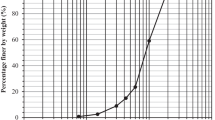Abstract
The use of continuous geosynthetic inclusions is involved in traditional soil reinforcing techniques such as geotextiles or geogrids, which are strong in tensile resistance. They protect the environment and promote a stronger planet by conserving energy and the earth’s resources through the production of durable and sustainable structures. In the present investigation, a numerical analysis is performed to understand the behavior of a square footing resting on geogrid reinforced soil. The numerical simulations were carried out using a three-dimensional FEM software, PLAXIS 3D. The numerical model was systematically validated with the results obtained from experimental studies. The effect of various factors such as embedment depth of first layer, spacing between consecutive layers and the multi-layers of the reinforcing elements are studied. It is observed that, four numbers of geogrid elements give the maximum bearing capacity ratio of 3.51 for an optimum depth of first layer and the spacing of 0.25B.
Access provided by Autonomous University of Puebla. Download conference paper PDF
Similar content being viewed by others
Keywords
1 Introduction
Unexpected bearing failures result in settlement have become a common issue under shallow foundations in recent times. It is not an economical approach to improve the soil strength by increasing the dimension of the footing. Inclusions of different sorts of materials mixed with soil have been used for thousands of years to strengthen the soil. Geosynthetic is an alternative and economical solution to improve performance by reinforcing the soil. Modern soil reinforcing techniques involve the use of continuous geosynthetic inclusions, such as geotextiles or geogrids, which are strong in tensile resistance (Abdi et al. 2009; Akpinar and Kutuk-Sert 2013; Harikumar et al. 2016; Hasan and Samadhiya 2018; Hatami and Bathurst 2006; Hegde and Sitharam 2017; Hotti et al. 2014; Kazi et al. 2015; Madhavi 2014; Madhavi and Vidya 2007). It is an innovative technique to solve difficult problems economically and expediently. The acceptance of geosynthetics in reinforced soil construction has been triggered by a number of factors, including aesthetics, reliability, simple construction techniques, good seismic performance, and the ability to tolerate large deformations without structural distress.
Most of the studies were conducted by employing field observations alone, and without much connection with numerical modeling. In the present investigation, an attempt has been made to evaluate the behavior of a square footing resting on 2D geogrids reinforced soil by performing numerical analysis. In designing complex structures, the numerical modeling would be helpful and are powerful tools that have been used to study the behavior of various structures under variety of loading conditions. It is advantageous in situations where the prototype structures are too big to be tested in laboratory.
Finite element method is the technique behind the software PLAXIS 3D. It is a powerful tool for the approximate solution of differential equations describing different physical processes. The study also investigates the influence of different parameters on bearing capacity of 3D geogrids reinforced sand beds.
2 Methodology
The experimental results reported by Makkar et al. (2016) have been used in the present study to validate the numerical model. They conducted laboratory scaled plate load test on geogrid reinforced sand bed using a steel tank of 750 mm × 750 mm size. In the numerical analysis, only a quarter portion of the test tank was modelled using symmetry to reduce the computational effort. In order to simulate the behaviour of soil, Mohr–Coulomb model was used. The square footing was modelled as a square plate of 25 mm thickness. The geogrid reinforcement used in the study was drawn in AutoCAD 3D and imported into PLAXIS 3D as shown in Fig. 1(all dimensions are in mm). The imported drawing has been modelled using the geogrid structural element available in the software. To carry out a finite element analysis using the PLAXIS 3D programme, the user has to create a three-dimensional geometry model composed of points, lines, surfaces, volumes, and other components. Geometry and mesh generated in PLAXIS 3D are shown in Figs. 2 and 3. The properties of materials used in the numerical analysis are given in Table 1.
Mohr–Coulomb model is selected for the analysis of soil and linear elastic model for geogrids.
A uniformly distributed pressure was applied on the top of the plate in the vertical direction to simulate the load on model footing and the corresponding settlements were found out. The displacement along bottom boundary was restrained both in horizontal and vertical directions. The side boundary was restrained only in horizontal direction, such that displacements are allowed in vertical direction.
3 Results and Discussion
The numerical results were validated with the experimental results reported by Makkar et al. (2016). The effect of various parameters on the bearing capacity of reinforced soil has been studied by conducting parametric study. Those are explained in the following section.
3.1 Optimum Depth of Top Layer of Geogrid (U)
To find the optimum depth of first layer of geogrid (u) from the base of the footing, it was placed at u/B ratios of 0.1, 0.25, 0.5, and 0.75, where B is the width of the footing. To quantitatively express the improvement in bearing capacity, a non-dimensional parameter bearing capacity ratio (BCR) is used. It is defined as the ratio of bearing pressure of reinforced soil at a given settlement (qr) to the bearing pressure of unreinforced soil at the same settlement (qur). Table 2 shows the BCR values for different u/B ratios.
It can be seen that the bearing capacity of reinforced soil increases up to a u/B ratio of 0.25, and thereafter it decreases. It means that sufficient overburden pressure is required above the reinforcement to mobilize maximum interfacial resistance, which is attained at a depth of 0.25 [2]. With further increase in u/B ratio, the bearing capacity reduces due to excessive settlement. With single-layer geogrid reinforcement at a depth of 0.25B, the BCR is 1.9. Therefore, the optimum depth of first layer of geogrid is taken as 0.25B from the base of the footing.
3.2 Spacing Between Consecutive Layers (B)
For the case of multi-layer reinforcement, geogrid elements are placed at b/B ratios of 0.1, 0.25, 0.5, and 0.75 by keeping the first layer at optimum depth in order to find the optimum spacing between the consecutive layers. From the BCR versus b/B graph given by Fig. 4, it can be seen that the bearing capacity of reinforced soil increases up to a u/B ratio of 0.25, and thereafter it decreases. A sufficient overburden pressure is required between each layer of geogrids to mobilize maximum interfacial resistance. And in this particular case optimum value of spacing was obtained as 0.25B, thereafter it starts to settle down other than offering the frictional resistance.
Figure 5 corresponds to the displacement distribution from PLAXIS 3D for the second geogrid layer placed at an optimum spacing (Fig. 6).
3.3 Number of Layers
From the graph shown in Fig. 7, it is clear that the bearing capacity of reinforced soil is increased with increase in the number of layers, as the reinforcement helps to spread the load to deeper soil layers where overburden pressure and confinement are higher.
4 Validation
Validation of the experimental study on the behavior of geogrid reinforced sand bed by Makkar et al. (2016) is done by the results from above numerical analysis. Effect of multi-parameters is studied with the PLAXIS 3D software and is systematically validated. A good match between the experimental and numerical results could be seen. The percentage deviation of results of the numerical analysis from that of the experimental study is within the allowable limit. The validation results are shown by the graphs as follows (Figs. 8, 9 and 10):
5 Conclusion
Numerical analysis was carried out to study the bearing capacity of model square footing resting on geogrid reinforced sand bed. The effect of depth to the first layer of reinforcement, spacing between two consecutive layers and the number of layers on the bearing capacity was investigated. Based on the results obtained from the numerical analysis by PLAXIS 3D, the major conclusions drawn are:
-
1.
The geogrid reinforced soil performs better than unreinforced soil.
-
2.
Frictional resistance at the interface of the sand and reinforcement which would have prevented the soil mass from shearing under vertically applied loads. Further, the soil might have resulted in getting confined within the cell and consequent mobilization of passive resistance mechanism to some extent (though no rigid connection exists between the geogrid elements). Strength improvement is heavily dependent on position of reinforcement within the sand bed.
-
3.
The optimum depth of the first layer of reinforcement was obtained as 0.25 times the width of the footing. With the provision of a single layer of reinforcement, the bearing capacity ratio of conventional geogrid increased to 1.9.
-
4.
The optimum spacing between two consecutive layers was obtained, when two layers were placed at a spacing of 0.25B.
-
5.
The bearing capacity of reinforced soil is increased with increase in the number of layers, as the reinforcement helps to spread the load to deeper soil layers where overburden pressure and confinement are higher. In the present study, the optimum number of layers was obtained as four with conventional geogrids.
-
6.
Four numbers of geogrid elements give the maximum bearing capacity ratio of 3.51 for an optimum depth of first layer and the spacing of 0.25B.
References
Abdi MR, Sadrnejad A, Arjomand MA (2009) Strength enhancement of clay by encapsulating geogrids in thin layers of sand. Geotext Geomembr 27(6):447–455
Akpinar MV, Kutuk-Sert T (2013) Shape analysis of geogrid with different aperture structures used for road subgrade reinforcement. International Baltic road conference, Lithuania, 23–28 August
Harikumar M, Sankar N, Chandrakaran S (2016) Behaviour of model footing resting on sand bed reinforced with multi-directional reinforcing elements. Geotext Geomembr 44(4):568–578
Hasan M, Samadhiya NK (2018) Soft soils improvement by granular piles reinforced with horizontal geogrid strips. Int J Geotech Eng 1–8
Hatami K, Bathurst RJ (2006) Numerical model for reinforced soil segmental walls under surcharge loading. J Geotech Geoenviron Eng 132(6):673–684
Hegde A, Sitharam TG (2017) Experiment and 3D numerical studies on soft clay bed reinforced with different types of cellular confinement systems. Transp Geotech 10:73–84
Hotti B, Rakaraddi PG,. Kodde S (2014) Behavior of square footing resting on reinforced sand subjected to incremental loading and unloading. Int J Res Eng Technol 3
Kazi M, Shukla SK, Habibi D (2015) Behaviour of an embedded footing on geotextile-reinforced sand. Proc Inst Civil Eng-Ground Improv 169(2):120–133
Madhavi LG (2014) Large diameter triaxial test on geosyntheic-reinforced granular sub bases. J Mater Civil Eng 04014148-1-8
Madhavi LG, Vidya SM (2007) Effects of reinforcement forms on the behavior of geosynthetic reinforced sand. Geotex Geomemb 25:23–32
Makkar FM, Chandrakaran S, Sankar N (2016) Settlement and surface heave characteristics of geogrid reinforced cohesionless soil. In: Indian geotechnical conference IGC2016
Author information
Authors and Affiliations
Corresponding author
Editor information
Editors and Affiliations
Rights and permissions
Copyright information
© 2020 Springer Nature Singapore Pte Ltd.
About this paper
Cite this paper
Sreya, M.V., Makkar, F.M., Sankar, N., Chandrakaran, S. (2020). Numerical Modelling of 2D Geogrid Reinforced Sand Bed. In: Latha Gali, M., P., R.R. (eds) Geotechnical Characterization and Modelling. Lecture Notes in Civil Engineering, vol 85. Springer, Singapore. https://doi.org/10.1007/978-981-15-6086-6_76
Download citation
DOI: https://doi.org/10.1007/978-981-15-6086-6_76
Published:
Publisher Name: Springer, Singapore
Print ISBN: 978-981-15-6085-9
Online ISBN: 978-981-15-6086-6
eBook Packages: EngineeringEngineering (R0)














